Megane Rs Sedan
► New Renault Sport Megane review
► Sport, Cup and Trophy versions tested
► Choices aplenty: manual, auto, different suspension setups
The latest Renault Megane R.S. polarised opinions when we tested the base 280 version: it handles superbly, especially on track, and it's crammed with inventive engineering, but left some of our testers a little cold on the road.
Our full, detailed review comprises tests of the Sport, Cup, Trophy and Trophy-R.Click here to read our first impressions of the Renault Megane R.S. Trophy and click here for the Trophy-R, or keep scrolling for our full review of all the Megane IV R.S. variants so far.
New Renault Sport Megane: need to know
The new Renault Megane IV R.S. is the third hot Megane to be developed by Renault Sport, the company's motorsport and high-performance road car division but it's based on the fourth-generation Megane, hence the potentially confusing numbering.
While the previous R.S. Megane was a two-door coupe, the new one is strictly five-door, like the rest of the current hatch's range. As before, two suspension set-ups are available: Sport (now designed to be more well-rounded for everyday use) and Cup (a more hardcore, track-focused arrangement).
Cup chassis pack-equipped versions cost around £1900 extra at the time of writing.
Choice of gearboxes: manual or paddleshift
The current Clio R.S. is available only with a paddleshift dual-clutch auto gearbox – a manufacturing decision that wasn't universally popular with fans. The Megane offers the choice of a full manual H-pattern, or 'EDC' (Efficient Dual-Clutch), both with six speeds.
To appease purists even further, the manual gearbox comes with a manual handbrake, too. The auto has an electric parking brake switch.
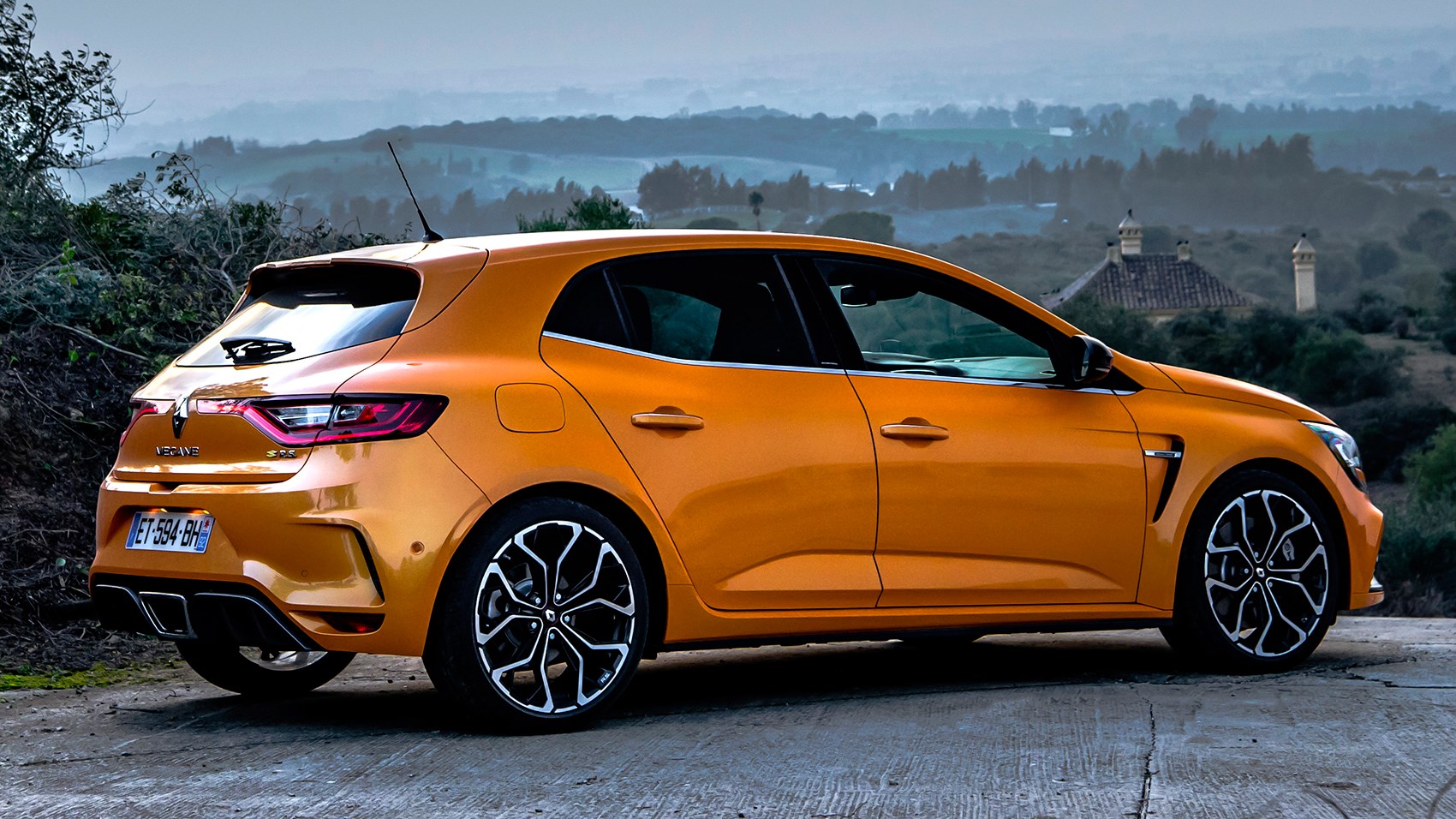
The manual gearbox is the exact same one used in the previous R.S. Megane but the lever now has a shorter throw and tighter gate.
An auto option is crucial for markets like Australia and Asia – the new car will be offered in as many as 50 markets, and part of its remit is to appeal to as many different buyers as possible.
What's under the bonnet?
The previous R.S. Megane had a 2.0-litre turbo engine, but the new car downsizes to a lighter aluminium 1.8 turbo, the same one found in the Alpine A110 sports car (also developed by Renault Sport).
In the regular R.S. 280 it develops 276bhp and 288lb ft, an impressive specific output for its size, although a deficit to the likes of the 296bhp Seat Leon Cupra 300, 316bhp Honda Civic Type R and 345bhp Ford Focus RS in today's power-crazed hot hatch market. The Trophy and Trophy-R makes up for that with 296bhp from the same engine.
Four-wheel steering is here
Albeit not on the Trophy-R to save weight. The smaller, mostly aluminium engine has saved weight, but a few pounds have been put back on by a new four-wheel-steering system.
While Ford's Focus RS and VW's Golf R have turned all-wheel-drive to manage their increasing power outputs, Renault Sport has stuck with front-wheel drive.
Its engineers said they briefly considered looking at using all-wheel-drive technology from within the Renault-Nissan alliance but quickly decided it 'wasn't ready for sports cars yet.' Instead, it claims the rear-steer ability has enabled a similar-magnitude step forward in agility.
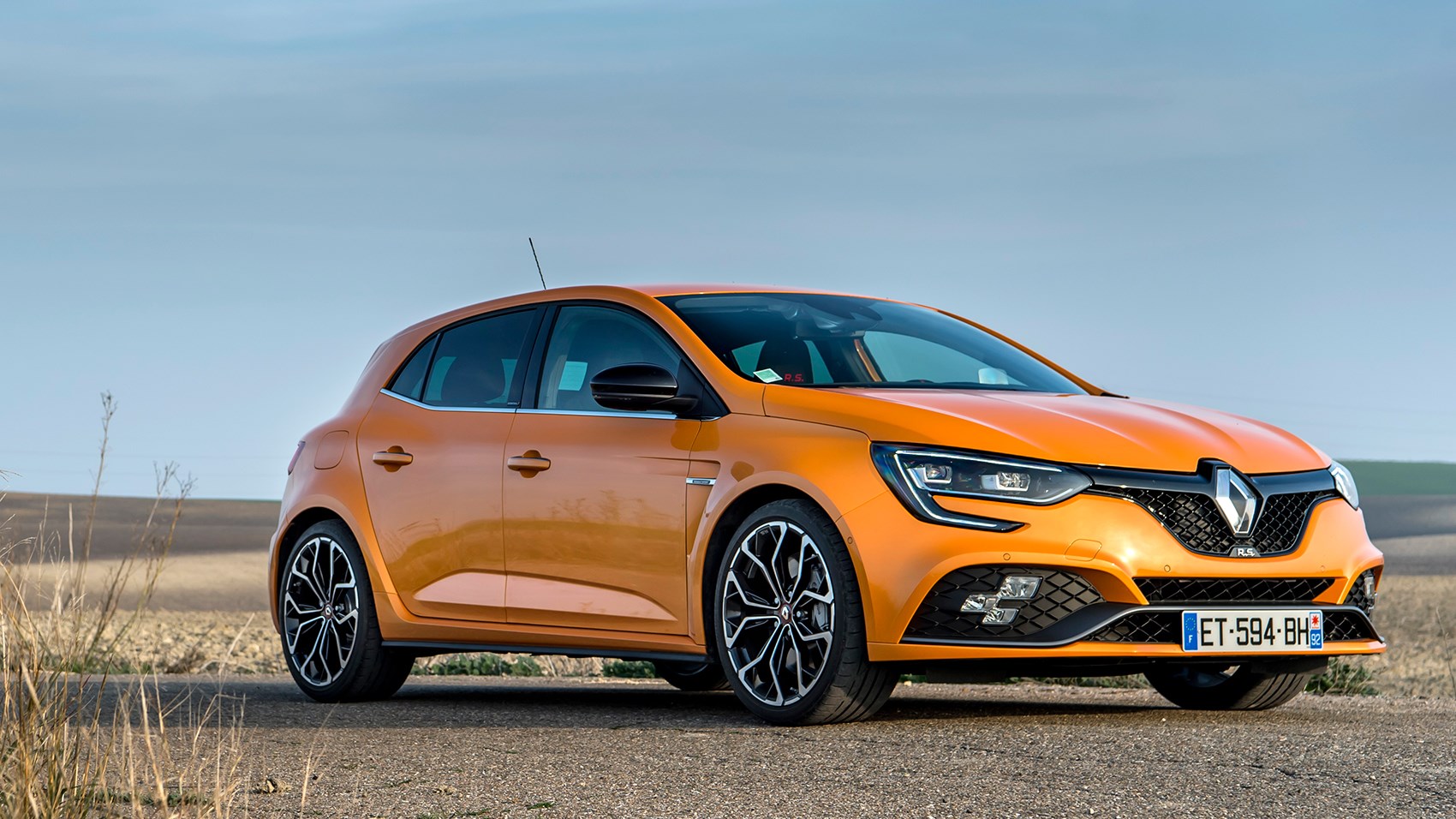
Below 37mph (or below 62mph if the car's in Race mode) the rear wheels turn in the opposite direction to the fronts, by as much as 2.7deg. This helps the nose dart into corners quicker or negotiate tight corners more easily. It also gives the car an incredibly tight turning circle for its size, which we've found genuinely useful in town.
At higher speed, they ever so slightly angle themselves in parallel with the front wheels, effectively lengthening the wheelbase for stability.
Four-wheel steering is established in high-end cars such as Porsche 911s, AMG GTs and certain Ferraris, but hitherto unheard of in hot hatches. The only other C-segment car to currently feature it is the Megane GT, the warm version of the regular car.
Two 280 versions: Sport and Cup
While the Cup is the exciting one, the regular Sport set-up is just as important to the Megane R.S. range, as it opens it up to a broader range of customers – those looking for an undemanding performance car to live with all year round. Golf GTI, 308 GTI, Focus ST and Leon Cupra territory, in other words.
The Cup, meanwhile is more focused on driver engagement on road and track. Natural rivals would be the likes of Honda's Civic Type R, Ford's Focus RS and the Performance Pack-equipped version of Hyundai's i30 N.
The Cup 'chassis' (by which Renault is referring to the suspension, rather than the car's structure) is around 10% stiffer overall compared with the Sport, and has its own specific tuning for the springs, dampers, anti-roll bars and hydraulic compression stops (derived from rallying and unique to the Megane's segment – they're standard on the Sport chassis too). Cup cars also get a mechanical limited-slip diff, and the option of lighter multi-material brakes.
Handy note: in most of these pictures, the Sport version is orange with regular alloys, Cup is yellow with black alloys.
Renault Megane R.S. 280 Sport review
As a fun but well-rounded, all-seasons hot hatch the standard Sport-spec 280 fulfils its brief well.
It rides well, it's agile and fun to drive – subjectively, I doubt you'd have more fun in a Golf GTI – and its surprisingly refined, with very little tyre roar or engine drone making its way into the cabin at a cruise.
The four-wheel-steering is subtle in its operation – more so than an AMG GT, for instance – and you quickly tune into it, and forget it's there. The new car is missing a little of the immediate, clear steering feel of previous R.S. Meganes. There's the slightest glaze of fuzziness that wasn't there before – maybe a result of the four-wheel-steer, maybe the redesigned front axle, maybe both – but the wheel doesn't give you quite as high-definition a picture of the road surface as it used to.
But what's missing in feel is made up for in response. Four-wheel steer has enabled Renault Sport to speed up the steering rate, and the amount of lock you need to put in has been reduced, especially in tight corners. The turning circle is city-car-small, too.
Unlike some of its rivals, the Megane R.S. uses passive dampers rather than electronically controlled adaptive shocks, and its rear suspension is a torsion beam while the Civic's is independent. The ride is really very supple in Sport trim (helped by those hydraulic compression stops), and yet the car corners very flat – a product of the four-wheel-steer, Renault Sport's engineers say.
The car's project manager Loic Feuvray says they'd rather sell two suspension setups with passive dampers and get them both right than use electronic dampers, which he describes as being 'always a compromise.' On the strength of this car's ride-handling ratio, his point of view makes sense.
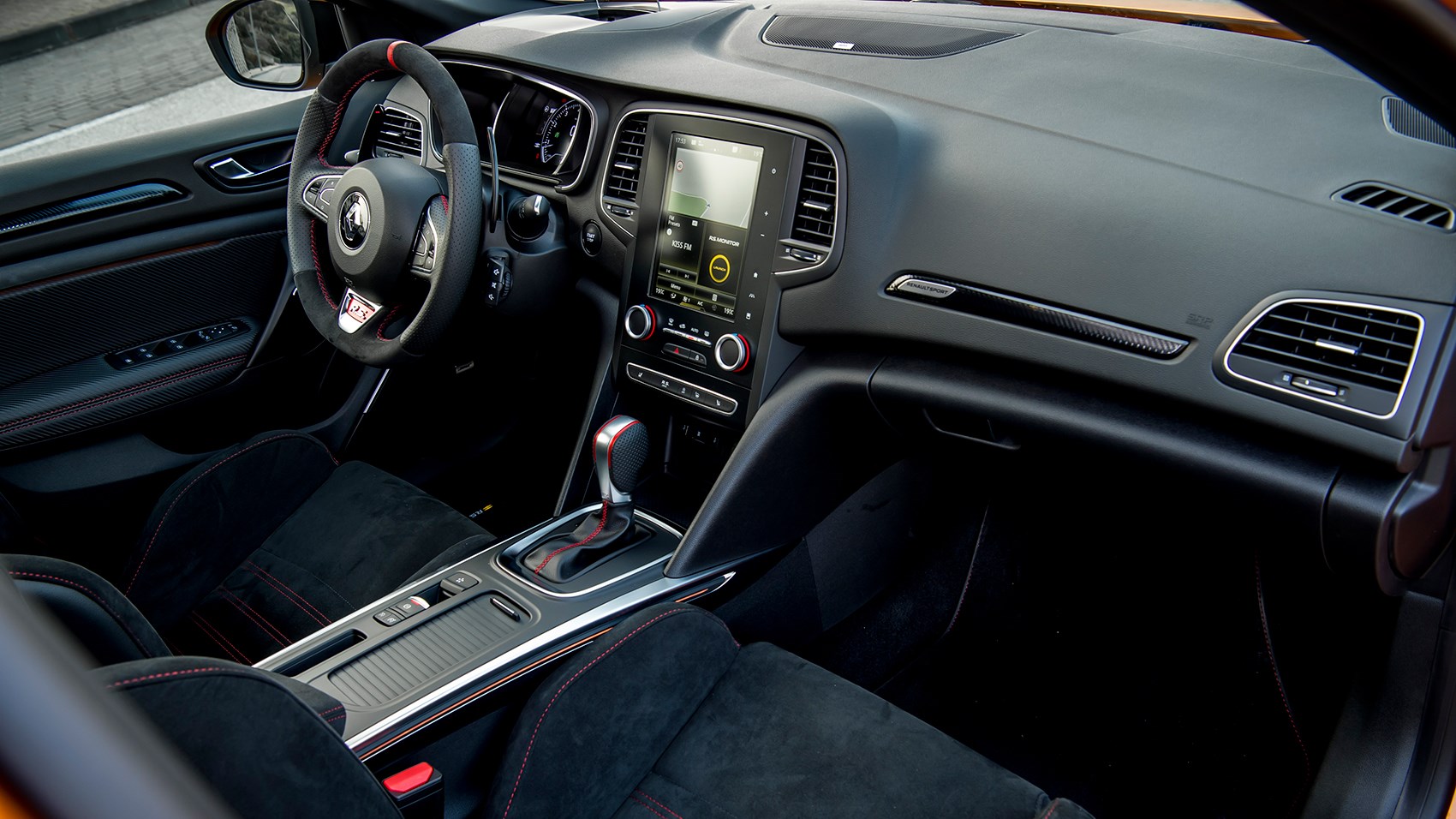
Occasionally the car's sheer width can make you breathe in a bit on narrow roads – seriously widened tracks make the front arches a full 60mm wider overall than the standard Megane, and the rears 45mm – but it's arguably worth it for the high-speed stability. Once you've tuned into it, it's a very confidence inspiring car.
The interior is a little nondescript, even with the red stitching and carbonfibre-effect leather trim on the doors. It's positively luxurious compared with the previous R.S., however. The steering wheel's a mix of leather and alcantara – unusually with the suede on the top and bottom of the wheel, where you probably won't hold it – while the seats are also trimmed in suede. They're good – deeply, but squidgily bolstered, easy to climb in and out of, supportive on twisty roads and reasonably kind to your (well, my) back on long distances. The footwell is incredibly broad for a performance car – the arches don't seem to intrude at all, and there's a giant footrest to brace yourself on.
The head-up display is clear, and there are plenty of places to store stuff. But the less said about the fiddly, laggy touchscreen the better.
Renault Megane R.S. 280 Cup review
On track, the Cup-spec Megane is seriously impressive. So too on the road, but to a lesser degree – it's not as exciting as previous hardcore Megane R.S. models, but it is very agile and adjustable. The ride is noticeably firmer than the Sport-spec car, as you'd expect, but not to the point of spoiling a journey.
Where the Sport uses its brakes to slow the inside wheel and tighten its line while cornering (which works well enough on the road), the Cup has a mechanical limited-slip differential. It's not electronically controlled – with rear-steer in the mix, Renault Sport felt the car was complex enough already on the computer-control front.
Whereas the previous R.S. Megane used a mechanical LSD by GKN, the new one is by Torsen and can transfer as much as 45% of total torque to the wheel that needs it most. It finds impressive traction, both in Sport mode and Race mode – which switches off the traction control and stability control.

Also impressive is the lack of torque-steer through the wheel. You can accelerate hard in a low gear on a smooth surface with little in the way of steering corruption, although crowned roads may require you to tighten your grip a little. As before, the Megane uses a dual-axis front axle with a separate hub carrier to lessen the effect of torque steer and cambered roads. It's a new design this time, however.
Just like the Sport on the road, it does feel like there's not quite the same thrillingly instant synapse response between the steering wheel rim and the front tyres that old Renault Sport Meganes do so well, but the steering is accurate nonetheless. And it's fast – no matter how tight the turn, you won't need much lock to get round it.
The rear-steer is much less noticeable in action on a circuit. It reduces the amount of lock you need to apply tight hairpins and in faster bends the virtual wheelbase extension helps make the car feel very stable, but still adjustable. The small-to-medium amount of downforce generated by the rear diffuser (which starts around the rear axle) and creditably demure-looking boot spoiler help here too.
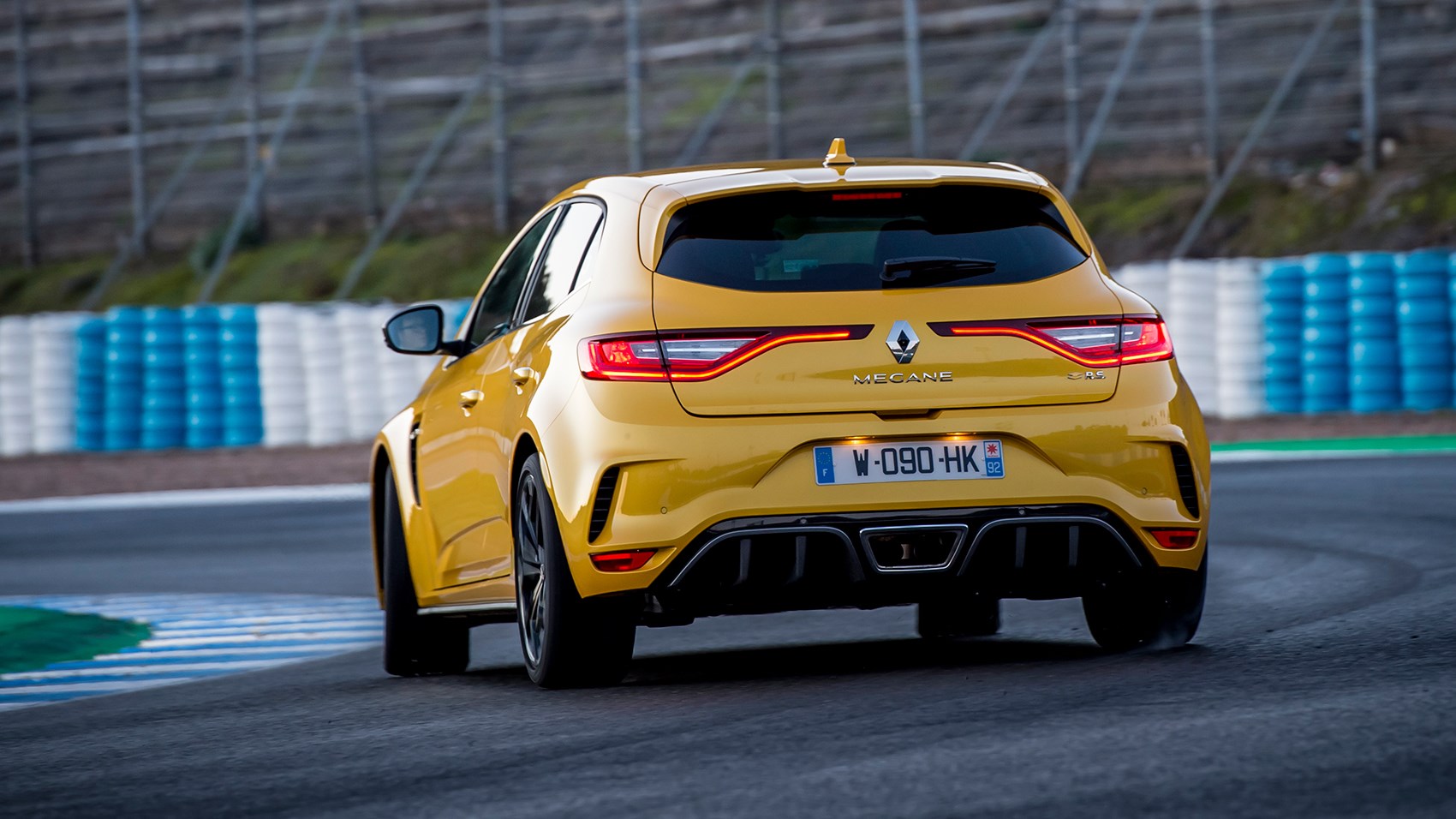
What's more, it's forgiving. Lift your foot from the throttle mid-corner, or tweak the wheel, and it'll slide on demand, but it does so progressively. It feels more predictable on the limit than its forebear.
Whereas 18-inch wheels are standard on Sport cars, and 19s an option, all Cup cars get 19-inch wheels. The brakes on the car we tested were the optional multi-material cast iron discs with aluminium centres, which save a hefty 1.8kg a corner in unsprung mass. They made a worrying groaning noise (the car had been given a pasting all week long on track) but their stopping power was impressive, as was stability under braking.
Sadly you can't switch off the automatically triggered hazard lights under heavy braking (a regulatory requirement for the road), which might get a bit annoying on a track day. The pedal needs a good firm press, and doesn't have much travel, which makes it ideal for heel and toeing. The pedal placement and the engine's keen response from low-to-mid revs helps in this regard, too. The Megane R.S. doesn't have automatic rev-matching, since Renault Sport says its customers enjoy doing the work themselves.
Renault Megane R.S. 300 Trophy review
The Megane R.S. Trophy is the hardest-core version. If the regular car in Sport trim is a well-rounded daily driver to rival the Golf GTI, the Trophy is a serious driver's car to rival the Civic Type R.
The Trophy is fitted with the Cup chassis as standard. Its suspension settings are identical – there are no changes to the springs, dampers and anti-roll bars.
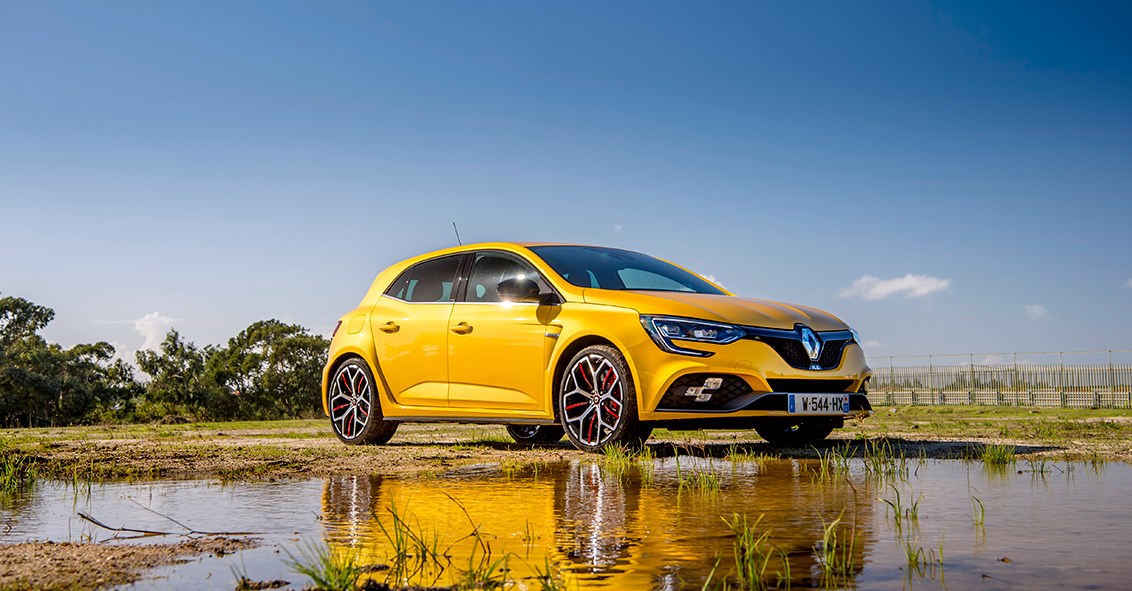
What it does get in exchange for its price increase of around £4000 (final UK pricing is TBC at the time of writing) is a power increase to 300 metric horsepower (296bhp), hence the 300 bit in the name. Torque is up too, to 296lb ft or 310lb ft in auto versions – the Trophy is available with both gearbox options.
It also features bi-material lightweight brakes, an option on the 280 but standard-fit on the Trophy, with new grooves for better durability when used hard on track. Lightweight Recaro seats trimmed in alcantara are standard, too. They're adjustable rather than fixed buckets. They're decently supportive, although the broad upper bolsters can pinch broad-shouldered drivers. That's come partly from a bigger turbocharger, and partly from a new exhaust, which features a new electronic valve system. Valves fully open its loud, crackly and really quite rude, but when you're trundling through town it's quiet and unobtrusive.
As standard the Trophy comes with some very tasty looking 19-inch wheels with red highlights inspired by the Renault R.S.01 concept, but lightweight rims saving an entire 2kg at each corner are an option. Add those to the lightweight brakes and there's a big chunk of unsprung mass missing from each corner.
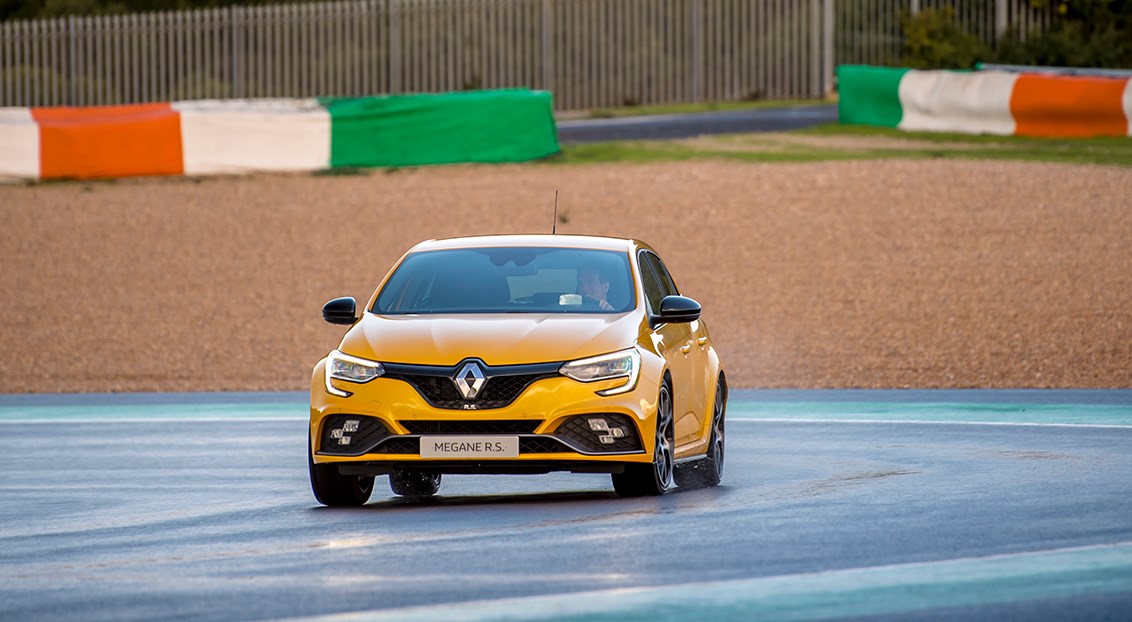
That may be part of the reason the Trophy feels so nimble and alive on the track. We tested it at Estoril, in the wet and the dry, and it's an extremely responsive and lively driving experience.
Tail-happy, too. In the wet it doesn't half oversteer. There's a lot of front-end grip from the new, bespoke Bridgestone Potenzas developed for the lightweight wheels and at the slightest lift from the throttle, the tail slews round to follow. It's very predictable however, and the steering is so fast you hardly need any lock to catch even the broadest of slides. The Torsen mechanical diff finds excellent traction, and you can straighten the car easily with the throttle as well as the steering.
It's one of the most accurate, adjustable and entertaining hot hatches for circuit driving that you can buy today.
The extra helping of power and torque means the Trophy does feel noticeably quicker than the 280 on the road. There's little lag from the bigger turbo (helped by expensive ceramic bearings), and the engine's flexible and willing to pull from low revs.
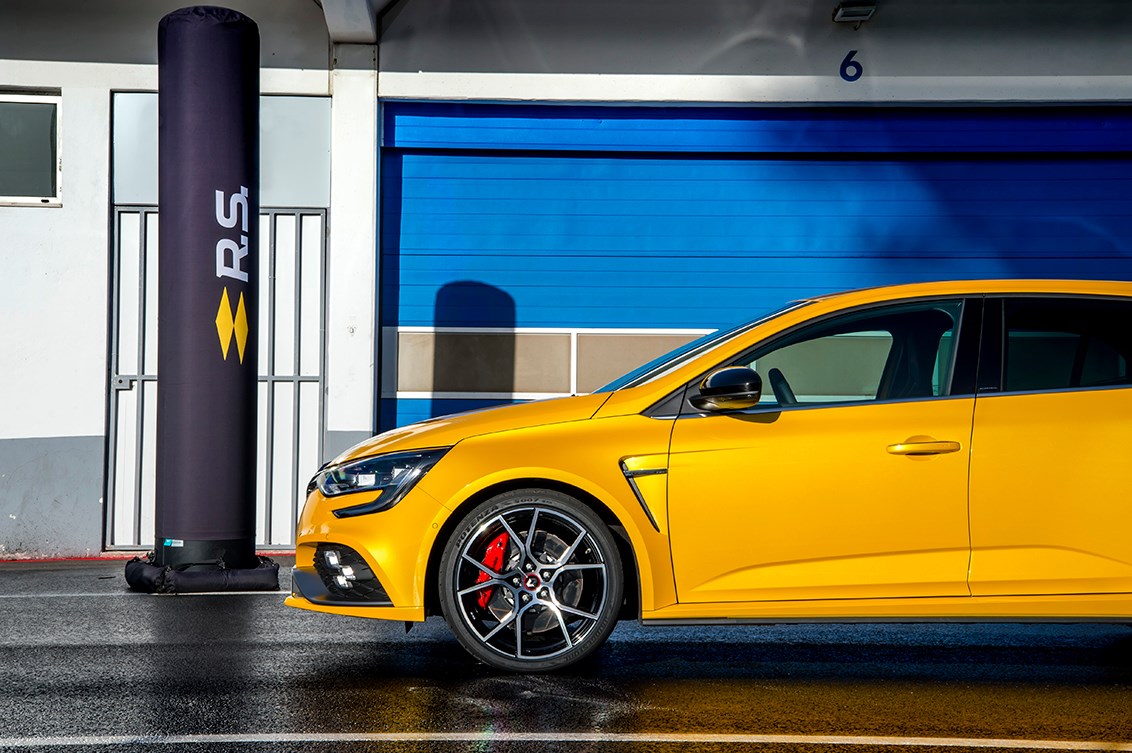
Although the Cup suspension settings are firm, the Trophy rides well on bumpy roads. It's jiggly yes, but never crashy, and body control is hard to fault. The exhaust is quiet when you're not pressing on, there's plenty of space in the back behind the narrow Recaro seats and you get the feeling it would be an easy car to live with as a daily driver.
It's perhaps less fun on the road than the circuit. Although it still has the likeable feeling of nimbleness on turn-in and stability under braking, the steering is relatively light, the manual gearchange is short-throw but a little vague feeling, and the engine is flexible but not particularly charismatic. While the Honda Civic Type R and Hyundai i30N Performance are ultimately less agile, the Civic is more communicative – it's a car where you find yourself changing gear just for the sake of it, because it's so pleasurable to do so – and the i30N's big-lunged engine is more charismatic.
Still, the Trophy is more inventively engineered than them both, more agile, and to many eyes more attractive.
Renault Megane R.S Trophy-R review
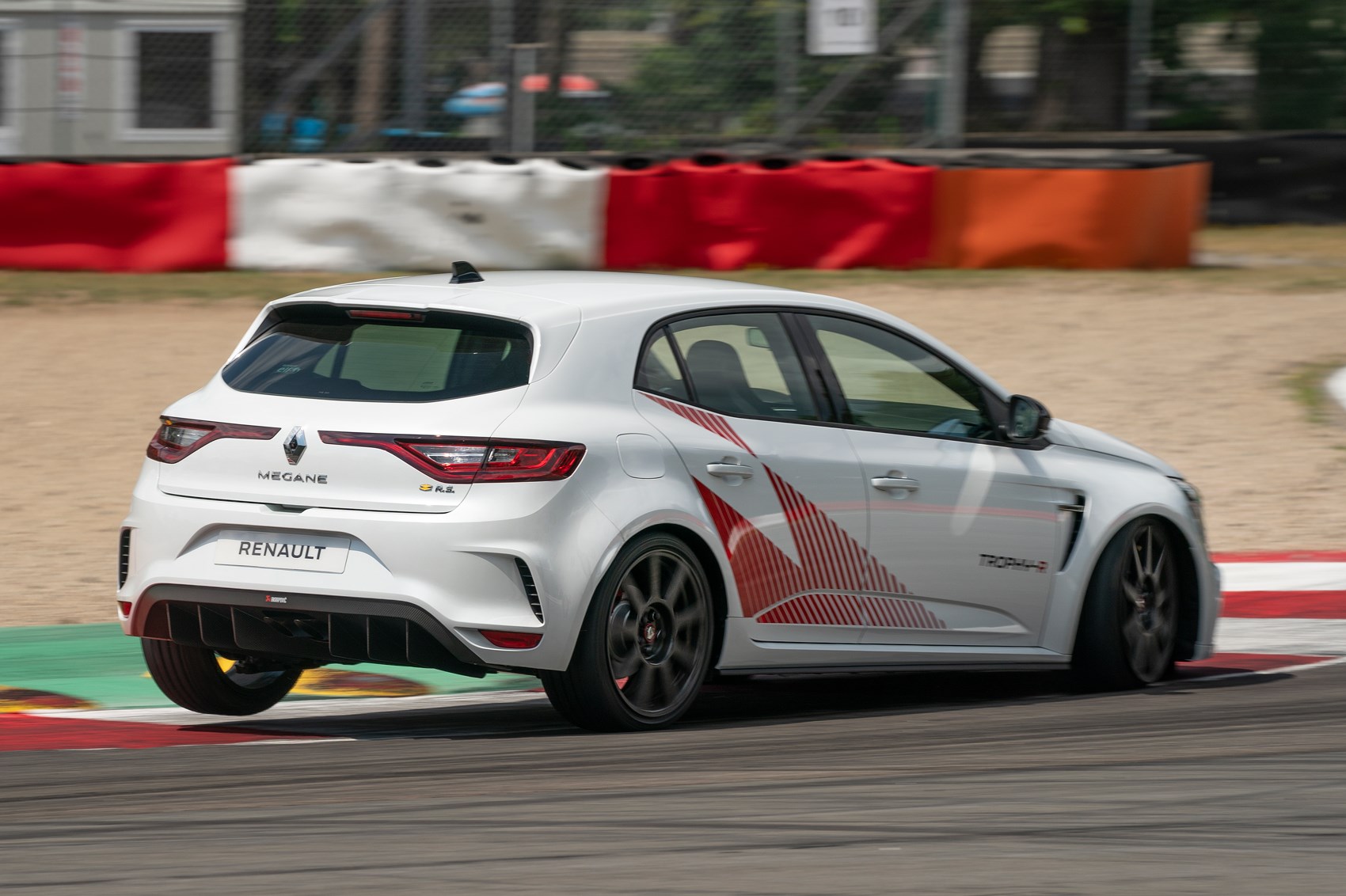
Renault reckons that it's track-focused Megan RS Trophy-R is about more than just a Nürburgring record (it's the fastest production FWD car to lap the circuit at 07'40"100), yet there's no denying it's a formidable feat considering today's crop of stellar hot hatches. From the old-guard Golf and 308 GTIs to Hyundai's fresh-faced i30 N and Honda's seemingly unbeatable Civic Type R, it's no longer a given than the newest release will indeed be the best.
The Trophy-R, then, provides the rawest, raciest, lightest version of the Megane RS – a car that we like a lot, yet could never quite put at the top of our hot-hatch favourites pile. It's taken us a while to get here – so has Renault finally made a car to blow the competition away?
The Trophy-R uses the same 296bhp 1.8-litre turbocharged unit as the 'regular' Trophy and the six-speed manual gearbox (no EDC auto' option for the Trophy-R) is also identical. That's fine in the case of the former – it's similar to the engine used in the Alpine A110 – but some love and attention towards the transmission wouldn't have gone amiss. It's notchy, incoherent and often imprecise – a million miles away from what the Civic Type R can offer.
Put the gearbox to one side however, and there's chassis changes galore to drool over. Instead of chasing more speed through extra power, Renault has looked to add lightness and improve aerodynamics – the Trophy-R dropping 130kg of kerbweight (coming in at 1306kg) and doubling the level of downforce. It's done this by making big changes as well as small, ranging from whipping out the back seats (-25.3kg) and 4Control all-wheel steering (-32kg) to redesigning the rear boot carpet (1.3kg) and using the 7.0-inch infotainment screen instead of the 8.7-inch version (-250g). Seriously.
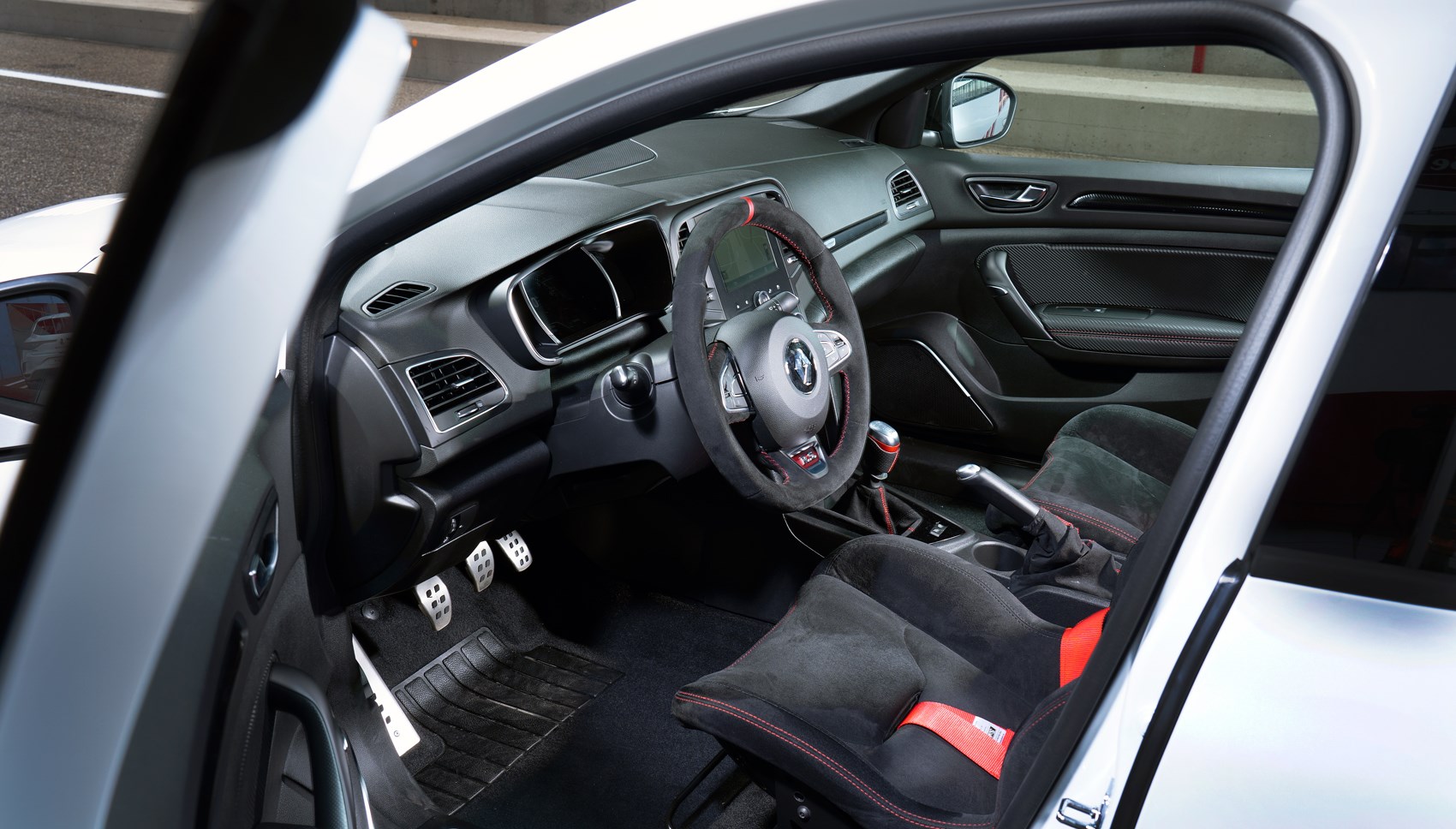
There's also a carbon composite bonnet (-8kg), Sabelt fixed bucket seats (-14kg), a titanium Akrapovič exhaust (-7kg plus heavy machinegun fire aplenty) and optional carbon wheels (-16kg). It's quite the crash diet, and together with the aero mods (fully reworked underbody, F1-inspired carbon rear diffuser and reworked brake scoops) makes quite the recipe on paper.
We'll caveat the following paragraphs by saying that we only got to drive the Trophy-R on a warm, dry Zolder circuit and will have to wait before delivering the definitive UK verdict. BUT, initial impressions were strong. Very strong. The Trophy-R feels like a step up from the Trophy, yet it also brings back a feeling of the old-school analogue hot hatches.
Whether it's the omission of the 4Control (effective but sometimes artificial) or just the good old-fashioned weight loss, the Trophy-R delivers proper, TCR-racer-aping ability with a layer of raw excitement added into the mix. It's not wild, out-of-control thrills, instead more focused on joy through precision and fleet-footed adjustability that you only get from the most nuanced of car setups.
Dual flow valve adjustable Öhlins dampers can be tweaked for stiffness and height (there's even a YouTube tutorial from Nürburgring lapper Laurent Hurgon on how to mimic his setup), while the deformable rear axle (with increased anti-roll stiffness) and camber change at the front give the Trophy-R a more tied-down feel than any other Megane RS. Get the weight transfer right and grip levels through, into and out of corners are startling.
You can still swing the rear end like a possessed pendulum, but the Trophy R feels happier to delicately pivot its derriere on corner entry, allowing you to work the Torsen limited-slip differential as you power out. And before anyone says anything about semi-slick custom-made tyres for the lap record, the Trophy-R wears the same Bridgestone Potenza S007's as the Trophy.
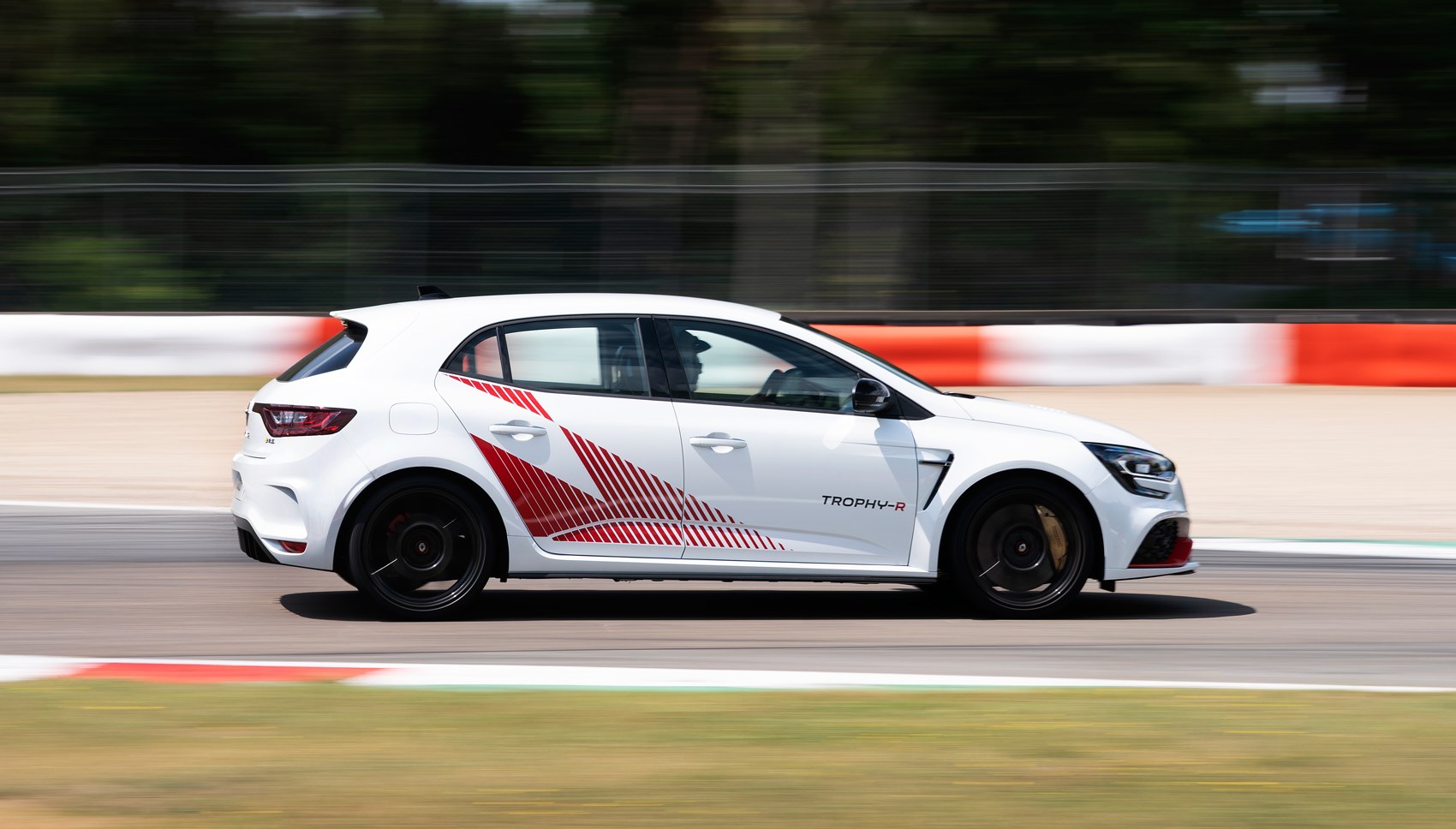
As for the steering feel – one of our primary complaints about the regular Megane RS – the lower kerbweight means feedback levels have been improved, although we'll have to reserve judgement until its channelled a wet, windy b-road near Stoke on a Tuesday night. That said, Renault's engineers did confirm that the Öhlins dampers could be adjusted to a setting softer and more forgiving than the Cup chassis setup, so the signs of a more compliant on-road demeanour are promising.
Special mention also has to go to the monstrously powerful carbon ceramic Brembo brakes – available as part of the Carbon Ceramic Pack (only 30 of the 500 Trophy-Rs will come with it) along with bumper-mounted air intake and carbon wheels. Coming with their own ABS and ESP map, power and feel from the carbon stoppers are superb, while fade is resisted admirably over a day on track. Oh, and the Sabelt bucket seats – they're damn good. Supportive, low and snug.
Megane R.S verdict
If the old R.S. Megane was a bit too hardcore for you, the Sport is a very credible modern hot hatch all-rounder – it's fun to drive, comfortable and easy to live with, without thrilling its driver to the same degree as Renault Sport hot hatches of old.
The Cup feels quicker over a lap and more stable and forgiving at high-speed than its predecessor, with a tighter, more fool-proof gearshift if you pick the manual and a credible alternative in the EDC. It's a seriously impressive track car, with higher abilities than most mainstream hot hatches. But for us the Honda Civic Type R is more exciting and involving to drive on the road, if less agile than the Renault. But the Megane's more subtle, well-resolved styling will likely be far more palatable to most buyers.
While the Trophy's extra power does make it feel more lively than the 280, unless you're likely to attend trackdays the advantages of its lighter brakes and seats aren't quite enough to separate it from the rest of the range on the road.
We've no doubt that the Trophy-R is the ultimate Megane RS, yet we'll have to try it on road before placing it with its R26.R and RS 275 Trophy-R brothers in the pantheon of hot-hatch greats. After all, we were never in doubt of the Megane RS' on-track abilities, instead feeling that it lacked the final layer of excitement and engagement (present in a Civic Type R) on the road.
How well the redesigned suspension copes without the super-smooth tarmac of Zolder will be key to the Trophy-R's success, as there's little doubt that the rest of the package (minus the gearbox and to a lesser extent the steering) is up to scratch. We're yet to see confirmed UK prices, but do know that customers in France will be charged 'approximately €55,000' for one of the 500 Trophy Rs set for production. UK customers will be getting 30 of those, with pricing and on-sale dates due in August 2019.
Our pick of the range would be the Cup chassis-equipped 280. It's well worth test driving the Megane against its rivals. While its forebears are perhaps more exciting to drive, it's more well-rounded and easier to live with than previously. It's an impressive modern hot hatch.
Specs for regular RS 280
Source: https://www.carmagazine.co.uk/car-reviews/renault/renault-megane-rs-2018-review/

0 Komentar